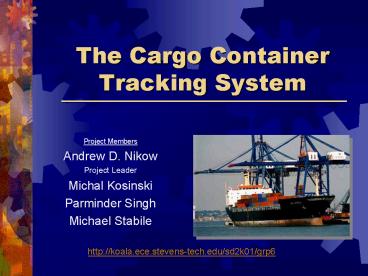The Cargo Container Tracking System PowerPoint PPT Presentation
1 / 18
Title: The Cargo Container Tracking System
1
The Cargo Container Tracking System
- Project Members
- Andrew D. Nikow
- Project Leader
- Michal Kosinski
- Parminder Singh
- Michael Stabile
http//koala.ece.stevens-tech.edu/sd2k01/grp6
2
Overall Project Requirements
- Our primary goal is to construct a prototype
transponder and gate reader system by Spring of
2002 - Additionally with the prototype be able to
exchange information from transponders to gate
while in motion - Ideally prototype systems can be constructed
using off-the-shelve components and development
kits - Ideally we would like to develop a standardized
system that can be developed to new and(or)
retrofit applications - Extensions of this system could include a
service-oriented tracking and tracing application
3
Contract Deliverables Status Report
- Business Model- Service and Product Model
Complete - Cost Estimation- Modeling
Complete - Product price- Research And Analysis Complete
- Design Economics- SEED Model Evaluation Complete
- Financial Leveraging- Evaluation
Complete - Break-even Analysis- Evaluation
completed - Sensitivity Analysis- Evaluation
completed
Incomplete Underway Complete
4
Completed Deliverables Summary
- Business Model Based on Product and Service
implemented in analysis - Research data based on similar product
development (Labor rates, equipment costs, taxes
,etc.) completed and integrated into final
analysis - SEED Model utilized to analyze both business
models under various conditions of financial
leveraging - Break Even Analysis and Sensitivity Analysis
completed based on Financial leveraging
conditions - Overall Evaluation on project worthiness
complete.
5
Business Model CCTS Product
6
Business Model CCTS Service
7
COST Estimation Results
- Type of Costs and their Range of Accuracy / -
10 - Improved accuracy based on real data collected
from similar product developments - Manufacturing plant (based on square footage /
space utilization) - Equipment (production rate and machinery usage)
- Operating Costs
- Fixed costs (taxes, utilities, supplies,
advertising) - Variable costs (labor, materials, overhead)
- Loan Expenses and Leveraging (interest, amount
borrowed)
8
Project Cost Information (1)
- Market Size
- Total Container Fleet worldwide is 13 million
TEUs. (possible estimate 9 million units) - Total Chassis Fleet worldwide is 900,000 units.
- Units Sold (based on 7-year lifespan of a cargo
container) - Inflation Rate of 4 Considered in analysis
9
Project Cost Information (2)
- Wireless Transponder
- Initial number of units sold 15000 with 30
increase in sales each year. (at end of 10years
product covers 9-10 of market share) - Price 60 25 labor 12 materials 55
overhead. - Wireless Gate Reader
- Units are not sold used by the company with
initial of units produced 150 and yearly
increase of 10 - Cost of manufacturing 430 50 labor 220
materials 60 overhead (maintenance). - Tracking Service
- Units served is equal to the number of units sold
that year plus the number of units sold up to
current year (with assumption that 7 years is the
life span and that about 2 of containers will
not require tracking that year) - Price 100/year 40 labor 0 materials
10
Design Economics
- Seed Model Results No Borrowed Capital
- NPV 1,340,088
- IRR 44.51 - very good and higher than 25 MARR
- Positive operating cost (EBIT) each year after
year 3 (that is very good) - Competitive prices in regards to competition
- (Qualcomm charges 600 per unit 250 per month
per driver service fee) Source CIO Magazine -
June 15, 2000
11
Design Economics
- Seed Model Results Borrowed Capital
- NPV 1,254,450
- IRR 46.85 - very good and higher than 25 MARR
- Positive operating cost (EBIT) each year after
year 3 (that too very good)
12
Financial Leveraging
- Using SEED model most economical case
- Initial capital investment 2,150,000
- Initial borrowed capital 200,000 at _at_12 APR
- Debt Ratio 9
- Increase in borrowed capital returns slightly
higher IRR but brings higher risks (much
greater debt ratio)
13
Revenues
- Wireless Transponder Unit
- Revenue (EOY 10) 56,032,630
- Wireless Gate Unit
- Revenue (EOY 10) 1,033,290
- Tracking Service
- Revenue (EOY 10) 278,244,975
14
Break Even Analysis
- Break Even Point occurs at middle of Year 3
after approximately 64 million in sales. - Revenue Surpasses Operating Expenses Almost
immediately
15
Sensitivity Analysis
- Most sensitive Revenue to IRR
- Also Expenses are very sensitive
16
Venture Funding Analysis
- Using Income Statement (SEED output) company can
use economical leverage for funding - Positive Factors
- Large market
- Available technology
- Establishment of a large customer base
- Good earnings forecast
- High rate of return (IRR high)
- Possible angels
- Transport / equipment leasing companies
- Government (tracking of hazardous materials)
- Military
17
Conclusions of Economic Analysis
- Project is Highly profitable
- Marketplace exists for product
- High Demand for this type of product
- Very competitive against existing current
products - Economic Analysis yields positive figures of
merit, exceeding minimum rates of return - Minimum investments would return significant
income. - Successful implementation of product will yield a
highly lucrative Service component. - Service component, based on successful deployment
of tracking system products will provide a
substantial sustainable source of income. - Creation of wide and substantial customer base.
- Great Expansion Opportunities.
- Ability to introduce and expand new products into
this customer base. - Global expansion capacity
18
QUESTIONS?
Pictures courtesy Interpool Inc.
http//www.interpool.com
CCTS Project Andrew D. Nikow Project
Leader Michal Kosinski Parminder Singh Michael
Stabile

